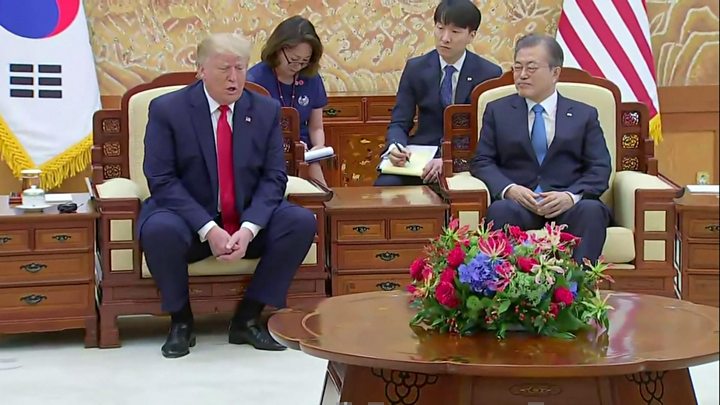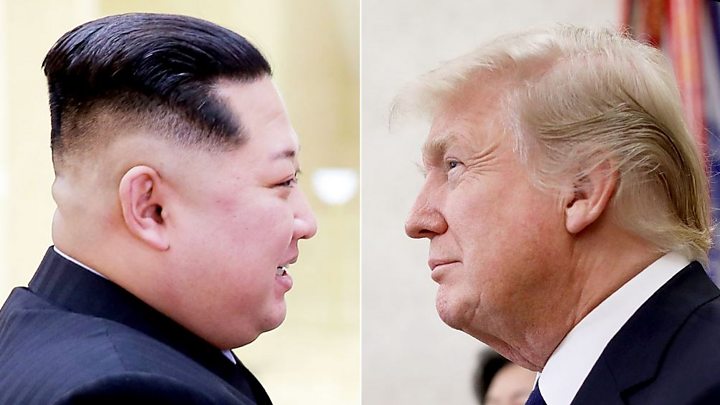
US President Donald Trump has confirmed he will meet North Korean leader Kim Jong-un at the demilitarised zone (DMZ) shortly for a brief greeting.
The unprecedented meeting comes after Mr Trump tweeted on Saturday an apparently spontaneous invitation to Mr Kim to join him on his visit.
In a joint press conference in Seoul, South Korea President Moon Jae-in confirmed the leaders would have a “handshake for peace” at the border.
North Korea has not yet commented.
It had previously said the offer was “interesting”.
Mr Trump told the press conference that he and Mr Kim had “developed a very good relationship” and he was looking forward to meeting him.
Apparently confirming that the invitation was not long planned, he said he arrived in South Korea and thought: “Hey, I’m here let’s see whether I can say hello.”
“It’s going to be very short, virtually a handshake. But that’s OK. A handshake means a lot,” he said.
Mr Moon said the leaders would meet in Panmunjom, the so-called truce village inside the border zone, where negotiations between South and North Korea have often taken place.
No sitting US president has ever been inside the DMZ (demilitarised zone), the thin strip of land which divides North and South Korea.
It will be Mr Trump and Mr Kim’s third meeting and Mr Moon said the timing of a third full summit “depends on what change today’s meeting and dialogue could generate”.
He told reporters that “peace takes more courage compared to tensions”.
Why will this meeting be significant?
With no time for the all important backroom diplomacy, it is expected to be largely a photo opportunity.
Negotiations with North Korea, to try to convince it to abandon its controversial nuclear programme, reached a peak last year when Mr Trump and Mr Kim had a historic meeting in Singapore.
They both committed to the “complete denuclearisation” of the Korean peninsula, but without clarifying what that meant.

It was hoped their second meeting, in Hanoi in February, would make some concrete agreement about North Korea handing over its nuclear programme in exchange for some of the tight sanctions against it being lifted.
- What to make of the Hanoi summit collapse?
- North Korea’s sidelined human rights crisis
- North Korea crisis in 300 words
But those talks ended with no deal, as they failed to agree on the pace at which sanctions should be eased.
Since then the negotiations have stalled, though Mr Kim and Mr Trump have exchanged letters in recent week.
So a handshake at the border would be largely symbolic, signalling their ongoing commitment to the process, but having a minimal impact on the progress of denuclearisation talks.
What is the DMZ?
The demilitarised zone (DMZ), which runs about 4km (2.5 miles) wide and 250km long, has divided the peninsula since the Korean War ended in 1953.
Image copyright
AFP
South Korean soldier stands guard at the truce village of Panmunjom inside the DMZ
Though that area, by definition, has no military installations or personnel, beyond it lies one of the most heavily militarised borders in the world.
The Joint Security Area (JSA) located at the Panmunjom village straddles the Military Demarcation Line and is where all negotiations between the two countries are held.
Tourists can also go to the JSA when relations between the two countries – still technically at war – allow it.
No US sitting US president has been inside it. Bill Clinton once described it as the “scariest place on Earth”.
What do the other countries involved want?
North Korea has been a significant topic of conversation on the sidelines of the G20 summit in Osaka this week.
All involved parties agree that it would be better if there were no looming nuclear threat on the Korean peninsula, but differ in their views on how this should be brought about.
Here’s a very brief guide to those involved and where they stand:
US-North Korea: Trump and Kim Jong-un to meet at DMZ







